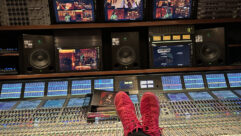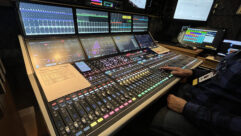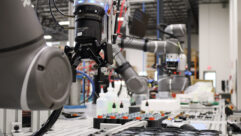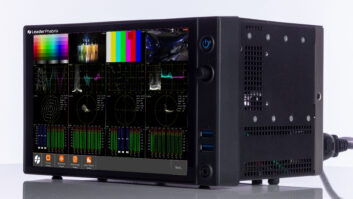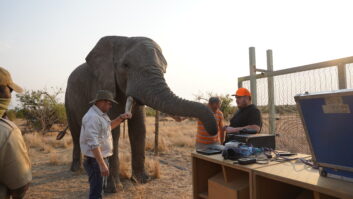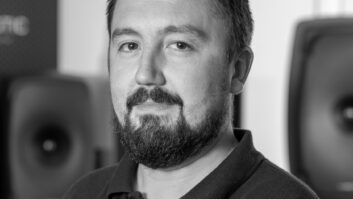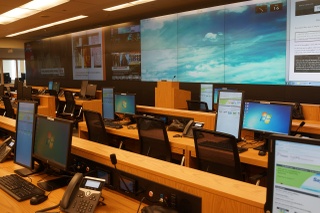
Richmond Hill, Ontario, Canada (June 2, 2015) — Sight N Sound Design Inc., a Canadian audio visual consulting, design and project management group, has installed seven Lectrosonics ASPEN Series audio processers to manage an extensive voice lift and headphone monitoring system at Ontario’s Provincial Emergency Operations Centre (PEOC). The emergency management command center, located within Toronto’s new $497 million Forensic Services and Coroner’s Complex (FSCC), is initially being deployed for the Pan American Games—the world’s third largest international multi-sport competition—in summer 2015.
Designed to provide centralized coordination of the Ontario government’s response to major emergencies and other events, the PEOC is staffed 24 hours a day and constantly monitors situations developing inside the province and beyond its borders. The command center is equipped with a 75-foot, 30-screen video wall and 24 ceiling speakers, and houses workstations for 82 participants.
Since each workstation position also includes a local loudspeaker plus an Audio-Technica gooseneck microphone, any number of which may be activated simultaneously, Sight N Sound chose five Lectrosonics ASPEN SPN1624 16 input/24 output processors to optimize speech intelligibility and to eliminate feedback in the voice lift system. The system is combined with a Lectrosonics ASPEN SPNDNT Dante networked processor plus an ASPEN SPN16i input expander and 18 DNTWP multi-I/O Dante audio interface wall panels, which together support individual source selection of various media, including television and computer-based audio, at each workstation.
According to Ken Lewis, president and founder of Sight N Sound, the key to successfully managing the PEOC voice list system is the implementation of a mix-minus feed, generated by the Lectrosonics processors, at each station. “All the microphones are mapped to various ceiling speakers, which are all home runs in separate zones, and all the desk speakers, so that we can achieve matrix mapping of every microphone,” Lewis explains. By generating and processing an individual mix for each workstation that includes all of the microphones in the room minus the one at the corresponding position, “Anybody can be heard or speak with good speech intelligibility, without any recirculated audio feedback,” he says.
“What really helps us in our work is the Adaptive Proportional Gain Mixing algorithm that Lectrosonics has a world patent on; we depend very much on that mixing algorithm. We’re always trying to achieve a state where anybody in a space will hear any participant who’s meant to speak and is equipped with a microphone as if they’re one meter away,” says Lewis, who established Sight N Sound more than 30 years ago.
The PEOC also benefitted from the latest evolution of a custom control panel design developed by Sight N Sound for a previous job. “We originally developed that panel for a courthouse project in Thunder Bay,” says Lewis. “At the PEOC we have 20 cable TV boxes, a satellite receiver and computers carrying audio. We’re taking those audio feeds into our Lectrosonics Dante matrix switching system. Each participant has a single-muff headset and from the touch panel can select whatever channels they need for that particular event.”
Lewis is appreciative of the relationship he has with Lectrosonics, for whom Sight N Sound is a significant customer. “It’s great when you have a manufacturer that you can call and talk to somebody who can visualize something in the field,” he says. “There’s a gentleman at Lectrosonics, Bob Cunnings, who’s their director of engineering, and he and I have really great conversations about possibilities.”
One of those conversations led to a new Mix Mode option in ASPEN’s automatic mixing software. “Lectrosonics very kindly developed for us a feature in their graphical user interface which they call Phantom Mode,” Lewis reports. The mode enables every microphone in a room to contribute to the auto mixing gain allocation while preserving the audio signal routing that has been defined in the mix-minus setup.
Lewis has fine-tuned the design of Sight N Sound’s voice lift systems during the implementation of more than 500 courtroom A/V projects throughout Canada and in Bermuda over the last few decades. “In all of our mission critical voice lift system applications we’ve always used Lectrosonics processors, from their first AM series, to the DM, through to the ASPEN series,” he says. Courthouse A/V systems can be complex, often comprising a combination of voice lift and recording, language interpretation, assistive listening, remote testimony and audio conferencing, as well as various video, lighting and other systems.
About Lectrosonics
Well respected within the film, broadcast, and theatre technical communities since 1971, Lectrosonics wireless microphone systems and audio processing products are used daily in mission-critical applications by audio engineers familiar with the company’s dedication to quality, customer service, and innovation. Lectrosonics is a US manufacturer based in Rio Rancho, New Mexico. Visit the company online at www.lectrosonics.com.



